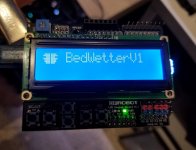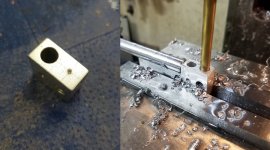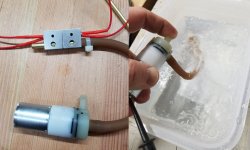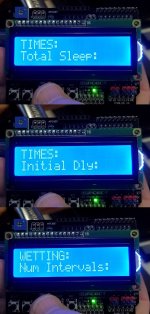- Messages
- 980
- Role
- Diaper Lover
- Little
BedWetter v0.3.2 and v0.3.34(ProfileCapacityTest) - updated 7/3/21 - https://github.com/DiaperHugger/BedWetter
Bed Wetting Simulator update log. This post is for further discussion about this project including but not limited to ideas and suggestions about the project and it's development. All are welcome to contribute and offer opinions about user experience and features.
I'm currently coding for Arduino platform with the features laid out by @johnzld and @PaSS . I'm limited on what I can do but don't mind learning as I go.
If anyone has some art skills and wants to create a simple logo please chime in!!! https://www.adisc.org/forum/threads/bed-wetting-simulator-art-contest.151880/
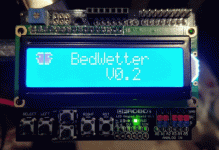
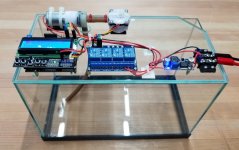
This version satisfies the initial function goals. Here is a flowchart of the current operation. Please see the github link for variable description and operation notes. Further refinement will continue. Hardware recommendations and construction details will be refined with user feedback. The next major addition will be a profiles random feature that will give a more tailored random experience. Integration of sensors for feedback will also be included soon. Stay tuned for updates!
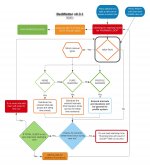
What works:
 www.adisc.org
www.adisc.org
--Update 5/2/21--
To better understand the features and overall goals I'm going to write a plan of attack for the BedWetter device. There are a few different levels of technical complexity as well as cost associated with the different possible design paths. I'll try to illustrate what I think the possible paths are. I see two possible groups of designs here. The DIY approach including simple and complex designs and the refined prototype/built that may be beyond the typical DIY.
It's cool that others have interest in bringing this thing to life. At this time I don't mind giving some of my free time to develop this project. How far it goes will be determined by the skill set of the people contributing. @Cottontail has even offered his skills around circuit design and possible prototyping. If others have offered to contribute and I missed a post please poke me again. I'm not totally sure how to coordinate this. It feels funny to call myself a project leader but if no one from the original post (@johnzld @PaSS) has any objections I don't mind seeing this through to it's conclusion as long as I have the time to give. I also have a fair bit of skill I can pull from. I can prototype the electronics side and have a small shop with tools. I also have a small MILL/CNC and 3d Printer for fabricating parts. Although the 3d Printer has a bit of dust on it. I can also design and make small prototype PCB's. For accessibility to others though the short term goals should probably involve premade modules or very simple circuits on a breadboard. I will definitely need help with coding. Thanks @PaSS!
Lets start with the overall goal of the device in a simple sentence. Later I'll give my opinion on which path to take and why. These opinions are based on my skill set and personal bias.
-The device should be able to control times and regulate water flow (with and with out heat) with the ultimate goal of causing the user to wake up with a wet diaper for certain or by chance.
The value to those who want a device like this will be the careful planning and understanding of the "function" of said device. The goal of "waking up wet" is a simplification of the end result. How this is achieved for best results will be understood best by those who understand the motivation to "wake up wet". This highlights the appropriate steps to make the end result as pleasurable as possible rather than simply just being "wet". For instance I don't fully understand the purpose of a "chance" that one could wake up wet. This being one of the features asked for by @johnzld. The want or need to wake up wet is shared by many on this forum. In my mind if the motivation to wake up wet drove me to use a device like this I would just as well wake up wet when ever I choose to use it and not let it be chance. But this is important to the design. I don't connect with this feature but obviously others do. This input will be valuable to the finished product as we do the heavy lifting for those who just want a working device. This is not to say that some features could be removed or deprecated in favor of a more conforming solution to the user experience. (god this sounds like corporate focus group gibberish)
Group One: DIY Simple
The simplest device has been mentioned on previous posts. At the most basic approach a simple drip feed from an elevated container of water directed by a tube into the diaper achieves the outcome of a wet diaper. The regulation of the liquid is achieved by way of adjusting the tube diameter or restricting the flow with a passive device. This flow would be determined within the use case of the specific system in question. Various containers such as hot water bottles, enema bags, or fish tank and tubing are a simple and relatively reliable method to achieve this. Warm water is achieved with pre-heated water in the case of the hot water bottles or enema bag. And fish tank heater for the fishy tank.
Group One: DIY Intermediate
This project is currently involved in the intermediate stage IMO. This includes but is not limited to, an electronic device that controls both time and regulation of the water. By relying on an electronic device the control over time and quantity of water introduced is greatly higher than the previous method. Features such as timed delay, frequency of wettings, and random chance are all possible. The water flow can be controlled by solenoid or pump. The current platform we're using is the Arduino UNO and the interface is the Arduino compatible LCD shield with buttons. This is a relatively simple and easy to obtain device with a great deal of support. This device may also include a method for regulating monitoring the heating process. This will come with some design challenges. There are devices on the market that can heat water and regulate it's temperature. These are mostly AC driven devices such as fish tank heaters or for food prep/cooking. These would be an addition to the control device rather than a specific built one so the control of these devices will be undoubtedly separate other than some basic on/off control using relay's.
Group One: DIY Advanced
The progression of the device into a more advanced version would necessarily be crafted by design choices beyond the basic functionality. I believe the better user experience is for the device to be compact and easy to setup. This would mean an integrated pump and heater as well as a simple and available water storage source. Things like a custom built on demand heating system with control and monitoring of water temps, flow meter and temp sensors for safety, and possibly a small touch screen UI. These features may most likely require a beefier processor like a small ARM based chip to interface with sensors and the screen. This level may also involve more advanced circuits such as power delivery/switching or custom PCB's. The device foot print would dictate the level of optimization needed depending on esthetics. I would love to see something like a handheld device that includes everything but the water source. This may be difficult depending on the physical size of the heat exchanger.
Group Two: Advanced prototype/product
The end game for a device like this would be a custom built product. This could include plans for building or ordering custom parts such as enclosures, custom PCB's, custom made heat exchanger and so on. Also including a refined UI and possible integration of Bluetooth or other external control schemes. This level of commitment would require a lot of time from those with the appropriate skills.
Considerations for cost.
The overall cost should be considered. The replication of an electronically controlled device should be easy enough. The Arduino ecosystem is vast and accessible. If the heavy lifting is done such as detailed diagrams, coding, and experimentation I believe this will be the best short term goal for those who want to build something that has controls tailored to the experience. A design of a device that can function within more than one level of complexity might be preferable. Such as a control unit that can be used on the most basic of designs but also have the capability of advanced features such as temp control feedback and flow monitoring will be easily integrated if the user wants to add the appropriate hardware. The ancillary hardware at different cost levels may be worth exploring. Things like the hanging bag of pre-heated water with a simple flow control on the low end. An integrated device that attaches to the top of a small fish tank with heater in the middle. A self contained device with pump, heater, and touch screen control on the high end.
That being said I'll offer my opinion here about how I would move forward.
The device I'm most interested in short term is an Arduino + LCD shield controlled pump. This is very familiar ground as I've done several projects similar to this. The coding needed to for the LCD interface is underway and I'm making progress. I will integrate the usage of a timed solenoid with duty cycle like @johnzld asked. However the solenoid as a flow regulator will probably be a dead end in the long run. The solenoid can be great to allow liquid to flow but that's about it. A pump would allow a much greater control over flow rates and quantities and would not cost much more than the solenoid. Coding for a control scheme of a pump should be introduced soon. The code for relay activation could also be used for the pump assuming it's also relay controlled. However a more precise method of PWM would be ideal. This would require the addition of a motor control circuit/module that's DIY or off the shelf parts. The addition of a controllable heater is also something I'm interested in. It will take some time but if something can be made that's small and safe to use I think it will be worth it for possible use with an all-in-one device later.
The technical write up including diagrams and setup for a working device will need to be placed on the github page. Right now it only functions as the most basic controller with hard coded times. https://github.com/DiaperHugger/BedWetter
I will continue to work on the code for now in my free time and post it to github.
Any design consideration and feature tweaks are welcome! I'll check in and consolidate them as I have time.
Bed Wetting Simulator update log. This post is for further discussion about this project including but not limited to ideas and suggestions about the project and it's development. All are welcome to contribute and offer opinions about user experience and features.
I'm currently coding for Arduino platform with the features laid out by @johnzld and @PaSS . I'm limited on what I can do but don't mind learning as I go.
If anyone has some art skills and wants to create a simple logo please chime in!!! https://www.adisc.org/forum/threads/bed-wetting-simulator-art-contest.151880/


This version satisfies the initial function goals. Here is a flowchart of the current operation. Please see the github link for variable description and operation notes. Further refinement will continue. Hardware recommendations and construction details will be refined with user feedback. The next major addition will be a profiles random feature that will give a more tailored random experience. Integration of sensors for feedback will also be included soon. Stay tuned for updates!

What works:
Total Sleep Time / hours
Initial Delay / minutes
Wet Intervals
Interval Durations / seconds
OutPut Pin select
Duty Cycle
Duty Pulse / seconds
Prime
LCD backlight control
Reset Settings
Random
Wet Chance
Profiled wettings
Secondary relay pin control
Optional temp and flow sensor
--Update 5/23/21--
BedWetter v0.3.1
Integration of secondary relay control. Added options for temp and flow sensors. The secondary relay pin and be controlled by the temp sensor but should only be used a back to a temperature controlled device for heating your water. Secondary relay pin can be activated with the LEFT button on the home screen. Added code to auto detect a compatible temp sensor. Read the README and MENU DESCRIPTION on the github.
--Update 5/18/21--BedWetter v0.2.6 (PROFILE TEST)
This is the first attempt at the profile system. For a description and discussion read this post.
BED WETTING SIMULATOR updates
Yes, first Test-runs are very good!!! (testing Normal Mode) ...will update soon... Normal Mode is 100% GOOD and working!!! Awesome thank you. (BedWetter 0.2.54)
--Update 5/2/21--
To better understand the features and overall goals I'm going to write a plan of attack for the BedWetter device. There are a few different levels of technical complexity as well as cost associated with the different possible design paths. I'll try to illustrate what I think the possible paths are. I see two possible groups of designs here. The DIY approach including simple and complex designs and the refined prototype/built that may be beyond the typical DIY.
It's cool that others have interest in bringing this thing to life. At this time I don't mind giving some of my free time to develop this project. How far it goes will be determined by the skill set of the people contributing. @Cottontail has even offered his skills around circuit design and possible prototyping. If others have offered to contribute and I missed a post please poke me again. I'm not totally sure how to coordinate this. It feels funny to call myself a project leader but if no one from the original post (@johnzld @PaSS) has any objections I don't mind seeing this through to it's conclusion as long as I have the time to give. I also have a fair bit of skill I can pull from. I can prototype the electronics side and have a small shop with tools. I also have a small MILL/CNC and 3d Printer for fabricating parts. Although the 3d Printer has a bit of dust on it. I can also design and make small prototype PCB's. For accessibility to others though the short term goals should probably involve premade modules or very simple circuits on a breadboard. I will definitely need help with coding. Thanks @PaSS!
Lets start with the overall goal of the device in a simple sentence. Later I'll give my opinion on which path to take and why. These opinions are based on my skill set and personal bias.
-The device should be able to control times and regulate water flow (with and with out heat) with the ultimate goal of causing the user to wake up with a wet diaper for certain or by chance.
The value to those who want a device like this will be the careful planning and understanding of the "function" of said device. The goal of "waking up wet" is a simplification of the end result. How this is achieved for best results will be understood best by those who understand the motivation to "wake up wet". This highlights the appropriate steps to make the end result as pleasurable as possible rather than simply just being "wet". For instance I don't fully understand the purpose of a "chance" that one could wake up wet. This being one of the features asked for by @johnzld. The want or need to wake up wet is shared by many on this forum. In my mind if the motivation to wake up wet drove me to use a device like this I would just as well wake up wet when ever I choose to use it and not let it be chance. But this is important to the design. I don't connect with this feature but obviously others do. This input will be valuable to the finished product as we do the heavy lifting for those who just want a working device. This is not to say that some features could be removed or deprecated in favor of a more conforming solution to the user experience. (god this sounds like corporate focus group gibberish)
Group One: DIY Simple
The simplest device has been mentioned on previous posts. At the most basic approach a simple drip feed from an elevated container of water directed by a tube into the diaper achieves the outcome of a wet diaper. The regulation of the liquid is achieved by way of adjusting the tube diameter or restricting the flow with a passive device. This flow would be determined within the use case of the specific system in question. Various containers such as hot water bottles, enema bags, or fish tank and tubing are a simple and relatively reliable method to achieve this. Warm water is achieved with pre-heated water in the case of the hot water bottles or enema bag. And fish tank heater for the fishy tank.
Group One: DIY Intermediate
This project is currently involved in the intermediate stage IMO. This includes but is not limited to, an electronic device that controls both time and regulation of the water. By relying on an electronic device the control over time and quantity of water introduced is greatly higher than the previous method. Features such as timed delay, frequency of wettings, and random chance are all possible. The water flow can be controlled by solenoid or pump. The current platform we're using is the Arduino UNO and the interface is the Arduino compatible LCD shield with buttons. This is a relatively simple and easy to obtain device with a great deal of support. This device may also include a method for regulating monitoring the heating process. This will come with some design challenges. There are devices on the market that can heat water and regulate it's temperature. These are mostly AC driven devices such as fish tank heaters or for food prep/cooking. These would be an addition to the control device rather than a specific built one so the control of these devices will be undoubtedly separate other than some basic on/off control using relay's.
Group One: DIY Advanced
The progression of the device into a more advanced version would necessarily be crafted by design choices beyond the basic functionality. I believe the better user experience is for the device to be compact and easy to setup. This would mean an integrated pump and heater as well as a simple and available water storage source. Things like a custom built on demand heating system with control and monitoring of water temps, flow meter and temp sensors for safety, and possibly a small touch screen UI. These features may most likely require a beefier processor like a small ARM based chip to interface with sensors and the screen. This level may also involve more advanced circuits such as power delivery/switching or custom PCB's. The device foot print would dictate the level of optimization needed depending on esthetics. I would love to see something like a handheld device that includes everything but the water source. This may be difficult depending on the physical size of the heat exchanger.
Group Two: Advanced prototype/product
The end game for a device like this would be a custom built product. This could include plans for building or ordering custom parts such as enclosures, custom PCB's, custom made heat exchanger and so on. Also including a refined UI and possible integration of Bluetooth or other external control schemes. This level of commitment would require a lot of time from those with the appropriate skills.
Considerations for cost.
The overall cost should be considered. The replication of an electronically controlled device should be easy enough. The Arduino ecosystem is vast and accessible. If the heavy lifting is done such as detailed diagrams, coding, and experimentation I believe this will be the best short term goal for those who want to build something that has controls tailored to the experience. A design of a device that can function within more than one level of complexity might be preferable. Such as a control unit that can be used on the most basic of designs but also have the capability of advanced features such as temp control feedback and flow monitoring will be easily integrated if the user wants to add the appropriate hardware. The ancillary hardware at different cost levels may be worth exploring. Things like the hanging bag of pre-heated water with a simple flow control on the low end. An integrated device that attaches to the top of a small fish tank with heater in the middle. A self contained device with pump, heater, and touch screen control on the high end.
That being said I'll offer my opinion here about how I would move forward.
The device I'm most interested in short term is an Arduino + LCD shield controlled pump. This is very familiar ground as I've done several projects similar to this. The coding needed to for the LCD interface is underway and I'm making progress. I will integrate the usage of a timed solenoid with duty cycle like @johnzld asked. However the solenoid as a flow regulator will probably be a dead end in the long run. The solenoid can be great to allow liquid to flow but that's about it. A pump would allow a much greater control over flow rates and quantities and would not cost much more than the solenoid. Coding for a control scheme of a pump should be introduced soon. The code for relay activation could also be used for the pump assuming it's also relay controlled. However a more precise method of PWM would be ideal. This would require the addition of a motor control circuit/module that's DIY or off the shelf parts. The addition of a controllable heater is also something I'm interested in. It will take some time but if something can be made that's small and safe to use I think it will be worth it for possible use with an all-in-one device later.
The technical write up including diagrams and setup for a working device will need to be placed on the github page. Right now it only functions as the most basic controller with hard coded times. https://github.com/DiaperHugger/BedWetter
I will continue to work on the code for now in my free time and post it to github.
Any design consideration and feature tweaks are welcome! I'll check in and consolidate them as I have time.
Attachments
Last edited:

